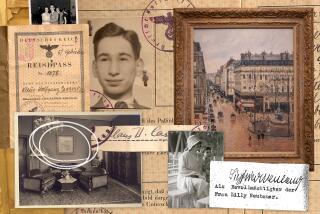Baron Collected With an Eye Toward America
Baron Hans Heinrich Thyssen-Bornemisza, who died Saturday at age 81 at his home on the northern Mediterranean coast of Spain, was the greatest art collector of the second half of the 20th century. Unlike his biggest rival for the title, L.A.’s Norton Simon, Thyssen had a head start--namely, a stunning collection of 525 Old Master paintings assembled by his father, son of a legendary Ruhr steel magnate, on which to build. When the father died in 1947, the stellar collection was divided among his children and heirs; but Hans Heinrich, the eldest and the one obsessed, spent more than a decade buying back everything he could that had been dispersed among his family.
Then, over the next several decades, he expanded the collection by a thousand more paintings, give or take a few.
Jan van Eyck, Piero della Francesca, Albrecht Durer, Raphael, Caravaggio--not a bad start on which to amass a huge hoard. The younger Thyssen added Petrus Christus, Duccio, Titian, Tintoretto, Lorenzo Lotto, El Greco, Watteau and Goya. The Impressionists, too, and the Post-Impressionists. And Picasso. And the Fauves, German Expressionists and Abstract Expressionists. And on and on--pictures that are not simply by impressive names but are also, more often than not, impressive examples from the individual artist’s body of work.
Still, one facet of Thyssen’s significance as a collector stands apart from this staggering litany of European masterpieces. It is not often enough remarked that the baron also assembled an impressive collection of late 18th to early 20th century American paintings. They range from three portraits by John Singleton Copley (1738-1815) to three nature abstractions by Georgia O’Keeffe (1887-1986). To an American audience, this might not seem odd, given an immensely rich collector of such acquisitive gusto. But Thyssen was a European, and to Europeans the paintings produced in the United States before World War II have typically been regarded (when they’re regarded at all) as minor at best and hopelessly provincial at worst.
There’s no mystery as to why. When cultural self-preservation is at stake, the Old World instinctively fends off the New. Think of it like this: Most prewar American art is to Europe what most pre-1980s L.A. art is to New York.
Among all the great museums of Europe, name one that can claim an important collection of 18th, 19th and early 20th century American art. You’ll find a Benjamin West here, a John Singer Sargent there, and Mary Cassatt was of course an American in Paris. Whistler’s tonal meditation on his mom famously hangs in the Louvre.
Lots of continental museums abundantly feature contemporary American art. But, if you’re in the European Union and want to see some Edward Hoppers, you have to go to Madrid. Today, there’s only one exceptional collection of earlier American art on public view in Europe, and it will be found in assorted rooms on the first floor and in galleries 29 and 30 on the second floor of the Thyssen-Bornemisza Museum, which was established as part of the Prado a decade ago.
When Thyssen let it be known in the 1980s that he was searching for a permanent public home for his collection, which had been installed for years in his private museum at his villa in Lugano, Switzerland, museum directors and government officials the world over stampeded to his door. (The exception was his home country, where sentiment seemed to be that the local billionaire could well afford to make his private museum public without their help--a view that ranks high on any list of penny-wise, pound-foolish decisions.) Among the suitors was the Getty, then in the throes of erecting its Brentwood acropolis.
The Getty had plenty of money to offer--far more than the $400 million or so that Spain eventually put up to acquire the art (valued at $2 billion) and refurbish a palace by the Prado Museum to house it. But money isn’t everything, especially when you already have a lot of it. Needless to say, it would have been very nice to be able to ride the tram up to the Getty Center and find the Thyssen collection waiting at the top. But although the collector had an eye for early American painting, he had no binding ties to the United States. An affiliation with the Prado, one of the great institutions of Europe, is tough competition.
Envy aside, it’s good how things worked out. A home for the collection in Madrid is distinctive in a way that a museum just about anywhere would be if it had a comprehensive collection of L.A. art. The name Thyssen is synonymous with the breadth and quality of Old Master painting, but for Europe the American collection is what makes his museum unique.
*
A virtual tour of the Thyssen-Bornemisza collection is available at www.museothyssen.org.
More to Read
The biggest entertainment stories
Get our big stories about Hollywood, film, television, music, arts, culture and more right in your inbox as soon as they publish.
You may occasionally receive promotional content from the Los Angeles Times.











